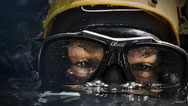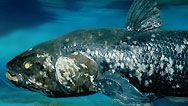Two Weeks Under the Sea
- By Kristen Clark
- Posted 08.28.14
- NOVA
Six miles off the coast of Key Largo and 63 feet below the ocean surface sits the world's only undersea marine laboratory, the FIU Aquarius Reef Base. There, researchers from Florida International University, Northeastern University, and MIT recently joined documentarian Fabien Cousteau for Mission 31. The month-long project aimed to study the effects of global warming and ocean acidification on nearby Conch Reef and raise awareness of fragile ocean ecosystems. Follow Liz Bentley Magee, a mission scientist, as she lives, works and sleeps under the sea.
Transcript
Two Weeks Under the Sea
Posted: August 28, 2014
Liz Bentley Magee: Somebody today asked me if I miss, like, running around in a field or something—I'm like, no! I'm running around on the bottom of the ocean!
This is so cool! For the last two weeks I've been living underwater as part of Mission 31. I was a mission scientist.
Hi.
Fabien Cousteau: You're here!
Magee: I'm here!
Cousteau: Welcome to your new home.
Magee: Thank you, good to see you!
Cousteau: You ready for this?
Magee: Aquarius is an underwater habitat. It is on the sea floor at 63 feet, and it houses up to six people at a time so you can conduct underwater research.
It's a one of a kind space underwater. There's no other marine lab underwater in the world.
The habitat is small. It's cozy—it's about the size of a school bus—400 square feet.
And as you can see outside the window, there's the ocean floor about 63 feet down. There's fish swimming around.
Normally, when I'm a surface diver I'm always worried about my bottom time. When you're diving to about 60 feet, you have about 60 minutes of bottom time, without risking the bends, or decompression sickness. And that's not very much if you're setting up experiments and trying to do science. But as an aquanaut, as a saturated diver, because we were living underwater for so long, we could dive for up to nine hours a day.
For our two weeks underwater we accomplished what we could have in about two years from the surface.
We came with five different science goals overall, looking at global climate change and how it might affect a coral reef such as Conch Reef where Aquarius is at. So, we took the approach of looking at tiny microclimates, such as inside a barrel sponge or inside the mouth of a tiny coral polyp to address what might happen if we have warming of the oceans—or if they're becoming more acidic in the environment surrounding these organisms.
Trainer: Got your chinstrap on good?
Magee: I think one of the most intense moments I've had underwater was during this first dive with the helmet where we had to flood the mask. We had to flood the helmet by lying down and breaking the seal at our neck and letting water in. And then we had to stand up and clear it out. And it was an instantaneous thing, it only took about 15 seconds, but still I was pretty nervous about that. After all the diving I've done, that was one of the most scary moments.
Sylvia is a goliath grouper. She hangs out around Aquarius habitat. They are able to use their anatomy to create this sound wave that travels through the water, which is their way of stunning prey or communicating with each other. There was a moment where I crept towards her and I was actually able to just hang out with Sylvia for about 20 minutes. And then right before she left, she boomed right at me and it went right through my chest. It's like being in a big rock concert or something.
And then she just kind of went away, like, "Alright, enough's enough, you had 20 minutes with me."
It looks like an aquarium from your viewpoint, but you are the aquarium. It is the ocean, and fish are looking in at you. And at night especially it starts with tiny plankton swarming to light around the habitat, followed by larger types of planktonic animals eating those, then small fish, and then bigger fish. It was like the food chain unraveling in front of the viewport every night. It was awesome.
Mark Hulsbeck: Alright we have permission. Secure your exhaust valves. Alright, commence blow down. Here we go…
Magee: It was kind of a rushed process, and pretty regimented, like, "Okay, put your mask on, your fins on, get into the water."
Aquarius crewmember: Alright, passing 4-0 feet, 40 feet.
Magee: I didn't get to reflect on it until we were hanging onto the line, and they were telling us to come up to the surface one at a time. And that's when I realized, we spent two weeks underwater and that this was it. I got kind of teary-eyed at that moment while hanging onto a line at 15 feet.
I didn't want it to end because it was so cool, and it was probably one of the most unique things I'm ever going to do.
Credits
PRODUCTION CREDITS
- Produced, Edited & Recorded by
- Kristen Clark
- Editorial help from
- Anna Rothschild
- Original Footage
- © WGBH Educational Foundation 2014
MEDIA CREDITS
- Scientist switch-out, Inside Aquarius, FIU Science Videos
- © Mission 31
- Aquarius Video
- Sea Monsters Revealed: The Exhibition, Courtesy of MacGillivray Freeman Films
- Additional Videos
- Francis Choi
- Mission 31 Splash Up Stills
- © Carrie Vonderhaar
- Sylvia (black background) Still
- © Kip Evans
- Liz and Sylvia Under Habitat Still
- © Matthew Ferraro, changing Tides/Mission 31
- Grouper2 (Diver and Goliath Grouper) Still
- Flickr/ Matthew Hoelscher (CC BY-SA 2.0)
- Music: Massive
- Podington Bear (soundofpicture.com)
IMAGE
- (main image: Aquarius)
- Sea Monsters Revealed: The Exhibition, Courtesy of MacGillivray Freeman Films
To learn more about Aquarius, Mission 31, and other science on the sea floor, visit these links:
- Mission 31: http://mission-31.com/about-mission-31/our-story/
- The FIU Aquarius Reef Base: http://aquarius.fiu.edu
- Helmuth Lab, Northeastern University: http://www.northeastern.edu/helmuthlab/
- Three Seas Program: http://www.northeastern.edu/threeseas/
Related Links
-

Hope for Coral Reefs
Coral reefs face a bleak future, but survival may come from a very unlikely place—the dark, cold depths of the ocean.
-

Extreme Cave Diving
A team of intrepid scientists journey into one of Earth's most dangerous and beautiful underwater frontiers.
-

Kings of Camouflage
Meet the cuttlefish, one of the brainiest, most bizarre animals in the ocean.
-

Anatomy of the Coelacanth
This survivor from the age of dinosaurs has body parts found in no other living creature.

